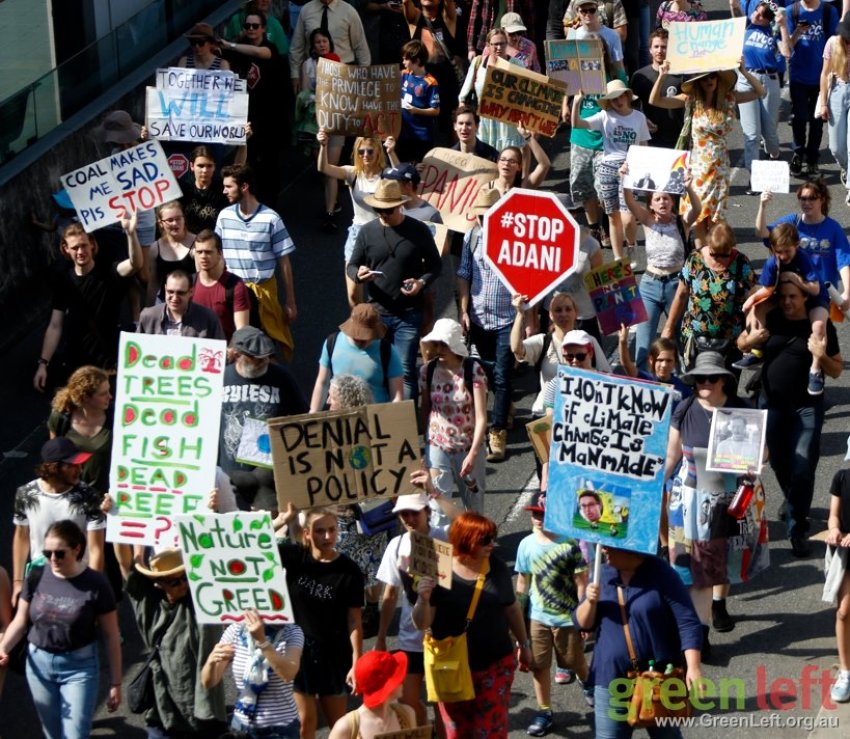
One of the more atypical protesters at the September 20 Climate Strike was Newcastle coal miner Ian Hodgson. But he exemplifies a large number of workers, including those in the fossil fuel industry, who want real action on the climate emergency, including new secure jobs for those who may lose theirs in any transition.
Hodgson is a fitter and turner at the Bayswater Power Station. He has spent much of his working life in or around mines and now, reluctantly, takes on coal-related work as a last resort.
“I try to do anything else I can first, but sometimes I’ve just got to pay the bills,” Hodgson told Crikey after the huge climate strike.
Hodgson says he is deeply concerned about the planet his children and grandchildren will inherit and is frustrated by the current debate.
“I can’t stand the way it’s made into an ‘us-versus-them’ scenario,” he said, referring to the disingenuous way politicians and corporate media frame calls for climate change as “attacks” on coal communities.
“Climate change affects all of us. You might work in a mine, but you live in the world.”
Hodgson is a representative of a growing number of workers who understand the looming threat of the climate crisis to the planet and lives of current and future generations.
The critical challenge facing unions and the new youth-based climate movement is to forge a strategic unity and help set a path for sustainable and real climate action, not quick fixes or detours.
Unions have a special responsibility to help this new movement in which all sorts of charlatans are, and will be, promoting a “cleaner” and “greener” capitalism as a solution.
Many workers in the energy industry know, instinctively, that relying on the private sector to fix things is not going to work. Unless the energy sector is brought into public hands, we have no chance to make the rapid transition we need given the seriousness of the climate emergency.
Some unions are taking a lead.
In Wollongong — a coal and heavy industry region — unions have launched a “Recharge the Illawarra” campaign for renewable jobs.
South Coast Labour Council secretary Arthur Rorris explained: “We know we’re exposed here — we are ground zero when it comes to carbon exposure because we have steelworks, coal mines and logistics right here on our doorstep.”
Rorris said it is a misconception that workers in the steel, mining, manufacturing, transport, education, construction and maritime industries do not want real action on climate change.
School Strike 4 Climate student organisers are well aware of the need to win over working people to the cause. They consciously added the call on governments to “fund a just transition and job creation for all fossil-fuel industry workers” to act as a bridge between themselves and those who could be caught up in the false “us versus them” refrain.
While the Australian Council of Trade Unions, state labour councils and many unions passed resolutions supporting the September 20 Climate Strike, thousands of unionists and other workers attended the rallies with their families or in work groups. Union banners were prominent in some cities, but the size of the contingents was limited.
Meanwhile, the Labor Party was hardly seen, save for some Labor Environmental Action Network activists.
The Labor leadership seems to have drawn the wrong conclusions from its defeat to the climate-denying Coalition in May, backing away from even a timid challenge.
While it is true that federal anti-union laws restrict the type of industrial action unions can take, it is also the case that it will be much harder for the climate movement to win even its immediate demands without serious union support.
The challenge union leaderships face is a critical one: to fully embrace the moderate demands of the climate students, the unions have to go against Labor policy.
In other words, they have to challenge Labor’s climate denialism.
To do this, rank-and-file members, particularly in the energy industry, will have to challenge union leaderships to come on board climate justice campaigns. This means committing in a serious way to help the next climate strike or mass action.
The more than 300,000 students who walked out of school on September 20 in Australia are the future of the union and workers’ movement. If the labour movement fails to stand firmly with them in their fight to save the planet, it will put unions in jeopardy. They will appear more and more irrelevant.
Climate action is union business. Conversely, joining in the struggle for climate action will dramatically revitalise the union movement. There is a lot at stake.
[Jim McIlroy is a retired former delegate in the Community and Public Sector Union (CPSU) and a member of the Socialist Alliance.]